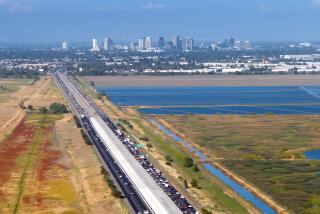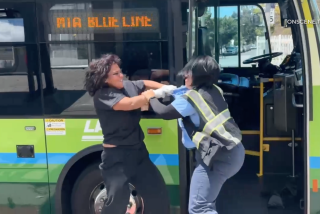Driving Ourselves Crazy : Road hogs got you ready to declare a PigAlert? Some motorists turn to squirt guns (risky!), others to anti-stress seminars for help in coping.
- Share via
You’re cruising in the fast lane down the San Diego Freeway doing about 65. It’s one of those too-rare times when traffic isn’t bumper-to-bumper, and you’re feeling good. Then, suddenly, some idiot races up to your back bumper and sits there, waiting for you to slump off into the next lane.
So you sit there thinking how you’d really like to cram his head into the steering wheel, while at the same time wondering whatever happened to “courtesy” and “defensive driving”--things they taught in high school that now seem as dated as a slide rule--and how L.A.’s streets got so mean.
Maybe it’s the millions of cars on the road. Or the fears of carjackings. Aging streets and freeways. Recession woes. Seventy-mile commutes, each way. The first casualty of this war is etiquette, and today’s road warriors have developed their own ways of coping.
In fact, driving has become so hazardous to the nerves that it’s a featured subject in stress-management seminars. And where professional driving schools used to deal with skidding and braking, now they’re tackling how to deal with rudeness.
Wilson McKee has found a way--potentially risky--to deal with drivers who cut him off or make dangerous illegal turns in front of him. He squirts the offending driver with one of those mega-squirt guns. Apparently nobody’s pointed anything back--yet.
“I needed something, just as an outlet,” says McKee, who’s been a driver/messenger for the Express Group messenger service in Westwood since last fall. “It relieves a little bit of stress. I have to be careful--some people have chased me, even though I’ve only hit them with water. Others just look at me really surprised. Once I caught someone on the 405 going over the hill to the Valley who was driving in a lane that was ending. He just passed tons of cars and then tried to merge. So I squirted him, and got a lot of thumbs up from other drivers.”
McKee, a recent transplant from Ohio, says: “When I started driving for Express, I was not really prepared for all the traffic that was out there, and how bad people really drove. The only way to survive is to drive like everyone else drives. There’s an occasional good Samaritan out there, but other than that it’s very much dog eat dog.”
Once he saw a driver pull out from a side street into a main thoroughfare without checking traffic first, causing an accident in which a Fiat spun around a few times. McKee said no other cars stopped.
“There’s that holier-than-thou attitude,” he says. “I’ve made a couple of mistakes once in a while, and I feel really embarrassed. I’ll say I’m sorry, put my hand up, apologize. I still try to have something of a conscience out there.”
A 32-year-old textile designer from the San Fernando Valley, who asked that her name not be used, puts some 15,000 to 20,000 miles on her Miata each year for work-related trips alone.
One of her major annoyances is “when you’re sitting in a traffic jam on the freeway and someone drives up on the shoulder. It’s always some jerk who thinks he’s too good to wait. So you kind of wedge your car there so he can’t get by.
“I think everyone is just out for themselves,” she adds. “They’re not looking out for the other person on the road. Like when you’re trying to get over to the freeway exit and someone’s refusing to let you off. Lots of times you pass these people and look at them and they’re in their own little world. Maybe they’re not doing this stuff on purpose, but they’re just in another world, not realizing how many thousands of cars are behind them.”
Freeway accidents that cause lane closures can also cause some pretty bizarre maneuvers.
Gary Gram has seen most of them. As a Caltrans associate transportation engineer and supervisor of a traffic management team, he’s at the sites of major incidents, such as accidents that block lanes of traffic.
“It gets to be a little scary sometimes,” Gram says. “There are people in those closed lanes on foot, and we’re trying to think safety all the time. . . . We’ll also see people going by, shouting or yelling at us, like, ‘Hey, why are you guys out there at 5 on a Friday closing lanes?’ I’m not choosing this. This is not a planned repair activity, it’s not our choice to go out there and close the lanes. It’s a little unsettling.”
Still, Gram acknowledges that in the 10 years he’s been doing this work for Caltrans, “things have gotten a little better compared with what I’ve seen in the past. People are starting to pay more attention to warning signs. That’s not to say that there isn’t room for improvement.”
The millions of cars choking the roads and freeways in Los Angeles County are an obvious and major contributing factor to why some people turn into Evil Speed Racer From Hell once they get behind the wheel.
Some 4,793,345 vehicles were registered in L.A. County in 1992; that’s up a little from 1988 (4,789,229) and actually down from a 1991 high of 4,860,169. But 4.8 million cars is 4.8 million cars, especially on days when it seems they’re all on the freeway at the same time.
More cars mean more traffic, which means slower traffic, which frustrates those in a hurry to get where they’re going, which seems like just about everybody.
When frustration turns to anger it can create dastardly behavior. That’s when etiquette takes a back seat.
Other explanations are legion: Drivers are distracted by reading, singing, eating, putting on makeup, shaving or talking on the car phone, making them less aware of what they’re doing and how they’re treating other drivers.
General urban crowding is also a factor in why some people become crazed drivers, says David Marple, professor of sociology at Loyola-Marymount University.
“People have a way of avoiding one another on crowded sidewalks,” he says. “If this translates to a car . . . and if we assume that California surface streets and freeways are as crowded as ever, that might exacerbate the feeling that people are continuously in a crowd. And that might be a factor in motivating people to take certain risks that might be abrasive in the eyes of others.”
Cars, he adds, afford people some sense of anonymity, “so they can just speed off and not have to worry about seeing the other person eyeball-to-eyeball. That can discourage a sense of wanting to follow through and be polite.”
An element of fear, Marple says, is another factor not to be ignored. Fear of carjackings, panhandlers and aggressive windshield washers adds to a sense of panic.
“It’s not just getting from Point A to Point B anymore, but getting there without being accosted or threatened. People no longer feel safe in their cars, and they’re trying to get through the public setting as quickly as possible.”
*
Those who don’t mind spending a few hundred dollars to improve their skills head out to a professional program, like the Willow Springs International Driving School in the Antelope Valley. In addition to competition road-racing classes, Willow Springs also offers a Precision Driving Workshop, where students are taught “the tools necessary to survive the perils of day-to761553273.
“We talk about not letting things affect your performance because it’s just going to cause you to be unbalanced,” says Willow Springs’ operations manager Robert Dixon. “You could cause an accident or make the accident worse. Panicking or driving angrily is definitely not conducive to safe driving. If you let it affect you, it’s going to affect your mood and performance. It’s just a mind set.”
Dixon was, by his own admission, “a maniac on the streets” when he lived in Los Angeles years ago, before he moved to the high desert. “If people cut me off, it was like I had a dinner plate on my shoulder, not just a chip,” he says. “I just realized how insane the city was.”
Now when he heads into L.A., “I don’t even bother honking at people. I just shrug it off. I’ve come to the conclusion that it really doesn’t make a difference. . . . Why do it? You just have to maintain your own sanity.”
Drivers who don’t quite grasp that concept can end up causing accidents or getting tickets. Going to traffic school is a short course in learning the errors of their ways.
Audrey Gramstad, who creates defensive driving courses for traffic violators for the Chicago-area based National Safety Council, studied rude drivers.
“When you live in big cities, there are too many people who think everyone is out to get them, so they’re going to get them first,” she says. “Their attitude is, ‘I don’t (care), I intend to get somewhere and everyone is in my way.’ I don’t know what people can do about it, it’s such a me-first attitude.”
Ken Nowack, an industrial psychologist, addresses dealing with traffic congestion and rude drivers in stress-management programs he takes to local businesses. Nowack, director of the Woodland Hills-based Organizational Performance Dimensions, teaches his clients relaxation techniques. “Visualize being on the freeway,” he tells them, “and . . . all the idiots who cut you off, and being in a hurry but not being able to go anywhere, and trying to carry an image of being relaxed and in control.
“Freeway traffic really represents the lack of control a lot of us have,” he says. “So the occasional courtesy sometimes disappears, and the unpredictable happens.”
But not everyone sees a city full of inconsiderate drivers out only for themselves. California Highway Patrol Officer Ernie Garcia, director of public affairs and media information, says: “I see a lot of courtesy out there. Although I do see some incidents of excess speed, I think the general public does do things like leave the left lane of the freeway open for people who want to travel faster than the norm.”
Garcia, who also teaches driver education and training for the Montebello Unified School District, adds:
“It’s a big responsibility of driver ed teachers to emphasize courtesy, and the fact that we all at one point or another may lose our temper, but we have to realize that we have to share the road. . . . You have to remember that there are good drivers and bad drivers, and they’re sharing the road with you. Maybe that person did not do what they did intentionally, and you just have to be tolerant. . . . You don’t have to point to someone and call him an idiot. We shouldn’t let our emotions get away from us because then it becomes a chain reaction.”






